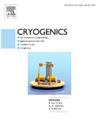集成4He吸附制冷机的亚开尔文绝热消磁制冷机的实验研究
IF 2.1
3区 工程技术
Q3 PHYSICS, APPLIED
引用次数: 0
摘要
实验研究了一种集成吸收泵的亚开尔文绝热退磁制冷机(ADR)。研制的ADR由高温超导(HTS)磁体、体积为10.4 cc的单晶钆镓石榴石(GGG)和集成的4He吸附冷却器组成。磁铁和吸收冷却器都将热量排除到商业4 K两级吉福德-麦克马洪(GM)冷却器中。吸附冷却器通过液氦的蒸发来提供冷却效果,液氦蒸发发生在氦气罐中,由充满活性炭的吸附泵驱动。为了将吸附冷却器与ADR集成在一起,GGG作为氦罐的蒸发器,通过连续循环运行来评价ADR的冷却性能。在再生过程中,GGG被磁化,氦气罐中充满从吸附泵中解吸出来的氦气。当4.1 t磁化的GGG和氦罐中的液氦被GM冷却器充分冷却后,开始吸附冷却过程,将GGG预冷至2 K以下。最后,通过外部转储电阻器放电磁铁使GGG退磁,达到最低温度0.29 K。在0.8 K时,ADR的最大制冷量估计为1.35 J/循环。详细的结果和发现将在本文的其余部分进行讨论。本文章由计算机程序翻译,如有差异,请以英文原文为准。
Experimental investigation on a sub-Kelvin adiabatic demagnetization refrigerator (ADR) integrated with a 4He sorption cooler
This paper experimentally investigates a sub-Kelvin adiabatic demagnetization refrigerator (ADR) with an integrated sorption pump. The developed ADR consists of a high-temperature superconducting (HTS) magnet, in which a single crystalline gadolinium gallium garnet (GGG) with a volume of 10.4 cc is installed, and the integrated 4He sorption cooler. Both the magnet and the sorption cooler reject heat to a commercial 4 K two-stage Gifford-McMahon (GM) cooler. The sorption cooler provides the cooling effect through evaporation of liquid helium, which occurs inside a helium pot and is driven by a sorption pump filled with activated charcoal. In order to integrate the sorption cooler with the ADR, the GGG serves as an evaporator of the helium pot. The cooling performance of the ADR is evaluated through a continuous cyclic operation. During the regeneration process, the GGG is magnetized, and the helium pot is filled with helium desorbed from the sorption pump. Once the 4.1 T-magnetized GGG and the liquid helium in the helium pot are sufficiently cooled by the GM cooler, the sorption cooling process is initiated to precool the GGG below 2 K. Finally, the GGG is demagnetized by discharging the magnet through an external dump resistor, achieving the lowest temperature of 0.29 K. The maximum cooling capacity of the ADR at 0.8 K is estimated to be 1.35 J/cycle. Detailed results and findings are discussed in the remainder of the paper.
求助全文
通过发布文献求助,成功后即可免费获取论文全文。
去求助
来源期刊

Cryogenics
物理-热力学
CiteScore
3.80
自引率
9.50%
发文量
0
审稿时长
2.1 months
期刊介绍:
Cryogenics is the world''s leading journal focusing on all aspects of cryoengineering and cryogenics. Papers published in Cryogenics cover a wide variety of subjects in low temperature engineering and research. Among the areas covered are:
- Applications of superconductivity: magnets, electronics, devices
- Superconductors and their properties
- Properties of materials: metals, alloys, composites, polymers, insulations
- New applications of cryogenic technology to processes, devices, machinery
- Refrigeration and liquefaction technology
- Thermodynamics
- Fluid properties and fluid mechanics
- Heat transfer
- Thermometry and measurement science
- Cryogenics in medicine
- Cryoelectronics
 求助内容:
求助内容: 应助结果提醒方式:
应助结果提醒方式:


